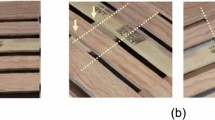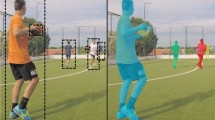Abstract
Solving complex computer vision tasks by deep learning techniques rely on large amounts of (supervised) image data, typically unavailable in industrial environments. Consequently, the lack of training data is beginning to impede the successful transfer of state-of-the-art computer vision methods to industrial applications. We introduce BlendTorch, an adaptive Domain Randomization (DR) library, to help create infinite streams of synthetic training data. BlendTorch generates data by massively randomizing low-fidelity simulations and takes care of distributing artificial training data for model learning in real-time. We show that models trained with BlendTorch repeatedly perform better in an industrial object detection task than those trained on real or photo-realistic datasets.
Access this chapter
Tax calculation will be finalised at checkout
Purchases are for personal use only
Similar content being viewed by others
References
Blender Online Community: Blender - a 3D modelling and rendering package. Blender Foundation, Blender Institute, Amsterdam (2020). http://www.blender.org
Deng, J., Dong, W., Socher, R., Li, L.J., Li, K., Fei-Fei, L.: Imagenet: a large-scale hierarchical image database. In: 2009 IEEE Conference on Computer Vision and Pattern Recognition, pp. 248–255. IEEE (2009)
Denninger, M., et al.: Blenderproc: reducing the reality gap with photorealistic rendering
Everingham, M., Van Gool, L., Williams, C.K., Winn, J., Zisserman, A.: The pascal visual object classes (VOC) challenge. Int. J. Comput. Vision 88(2), 303–338 (2010)
He, K., Zhang, X., Ren, S., Sun, J.: Deep residual learning for image recognition. In: Proceedings of the IEEE Conference on Computer Vision and Pattern Recognition, pp. 770–778 (2016)
Heindl, C., Zambal, S., Scharinger, J.: Learning to predict robot keypoints using artificially generated images. In: 24th IEEE International Conference on Emerging Technologies and Factory Automation (ETFA), pp. 1536–1539. IEEE (2019). https://doi.org/10.1109/ETFA.2019.8868243
Hintjens, P.: ZeroMQ: messaging for many applications. O’Reilly Media, Inc. (2013)
Hodan, T., Haluza, P., Obdržálek, Š., Matas, J., Lourakis, M., Zabulis, X.: T-less: An rgb-d dataset for 6d pose estimation of texture-less objects. In: 2017 IEEE Winter Conference on Applications of Computer Vision (WACV), pp. 880–888. IEEE (2017)
Hodaň, T., et al.: BOP challenge 2020 on 6D object localization. In: European Conference on Computer Vision Workshops (ECCVW) (2020)
Kingma, D.P., Ba, J.: Adam: a method for stochastic optimization. ar**v preprint ar**v:1412.6980 (2014)
Krizhevsky, A., Sutskever, I., Hinton, G.E.: Imagenet classification with deep convolutional neural networks. In: Advances in Neural Information Processing Systems, pp. 1097–1105 (2012)
Paszke, A., et al.: Pytorch: an imperative style, high-performance deep learning library. In: Advances in Neural Information Processing Systems, pp. 8026–8037 (2019)
Sadeghi, F., Levine, S.: Cad2rl: real single-image flight without a single real image. ar**v preprint ar**v:1611.04201 (2016)
Schwarz, M., Behnke, S.: Stillleben: realistic scene synthesis for deep learning in robotics. ar**v preprint ar**v:2005.05659 (2020)
Shorten, C., Khoshgoftaar, T.M.: A survey on image data augmentation for deep learning. J. Big Data 6(1), 60 (2019)
Simonyan, K., Zisserman, A.: Very deep convolutional networks for large-scale image recognition. ar**v preprint ar**v:1409.1556 (2014)
To, T., et al.: NDDS: NVIDIA deep learning dataset synthesizer (2018). https://github.com/NVIDIA/Dataset_Synthesizer
Tobin, J., Fong, R., Ray, A., Schneider, J., Zaremba, W., Abbeel, P.: Domain randomization for transferring deep neural networks from simulation to the real world. In: 2017 IEEE/RSJ International Conference on Intelligent Robots and Systems (IROS), pp. 23–30. IEEE (2017)
Tremblay, J., et al.: Training deep networks with synthetic data: Bridging the reality gap by domain randomization. In: Proceedings of the IEEE Conference on Computer Vision and Pattern Recognition Workshops, pp. 969–977 (2018)
Yu, F., Wang, D., Shelhamer, E., Darrell, T.: Deep layer aggregation. In: Proceedings of the IEEE Conference on Computer Vision and Pattern Recognition, pp. 2403–2412 (2018)
Zhou, X., Wang, D., Krähenbühl, P.: Objects as points. ar**v preprint ar**v:1904.07850 (2019)
Acknowledgements
This work was supported by the strategic economic and research program “Innovatives OÖ 2020” of Upper Austria and by the European Union in cooperation with the State of Upper Austria within the project Investition in Wachstum und Beschftigung (IWB).
Author information
Authors and Affiliations
Corresponding author
Editor information
Editors and Affiliations
Rights and permissions
Copyright information
© 2021 Springer Nature Switzerland AG
About this paper
Cite this paper
Heindl, C., Brunner, L., Zambal, S., Scharinger, J. (2021). BlendTorch: A Real-Time, Adaptive Domain Randomization Library. In: Del Bimbo, A., et al. Pattern Recognition. ICPR International Workshops and Challenges. ICPR 2021. Lecture Notes in Computer Science(), vol 12664. Springer, Cham. https://doi.org/10.1007/978-3-030-68799-1_39
Download citation
DOI: https://doi.org/10.1007/978-3-030-68799-1_39
Published:
Publisher Name: Springer, Cham
Print ISBN: 978-3-030-68798-4
Online ISBN: 978-3-030-68799-1
eBook Packages: Computer ScienceComputer Science (R0)





